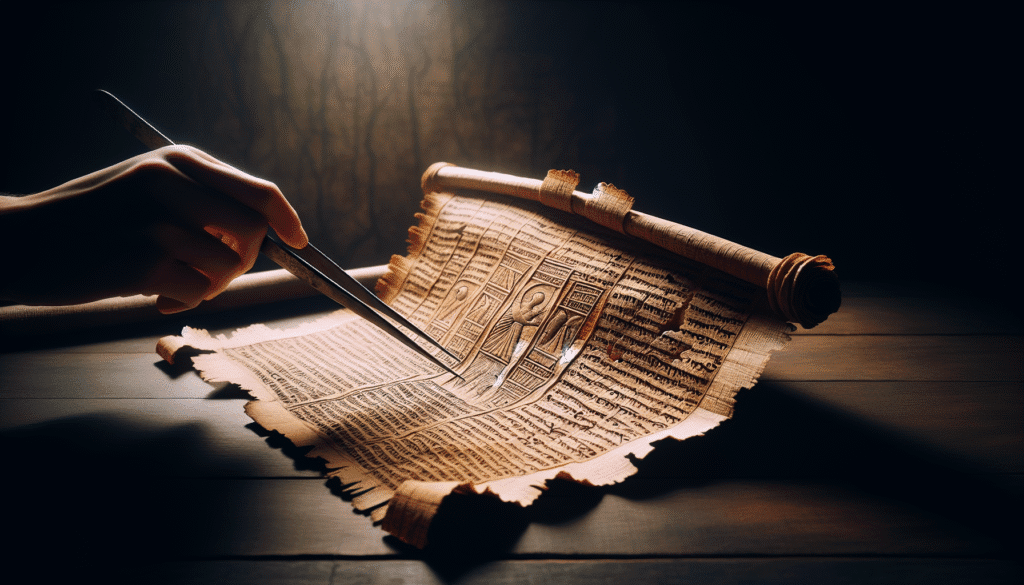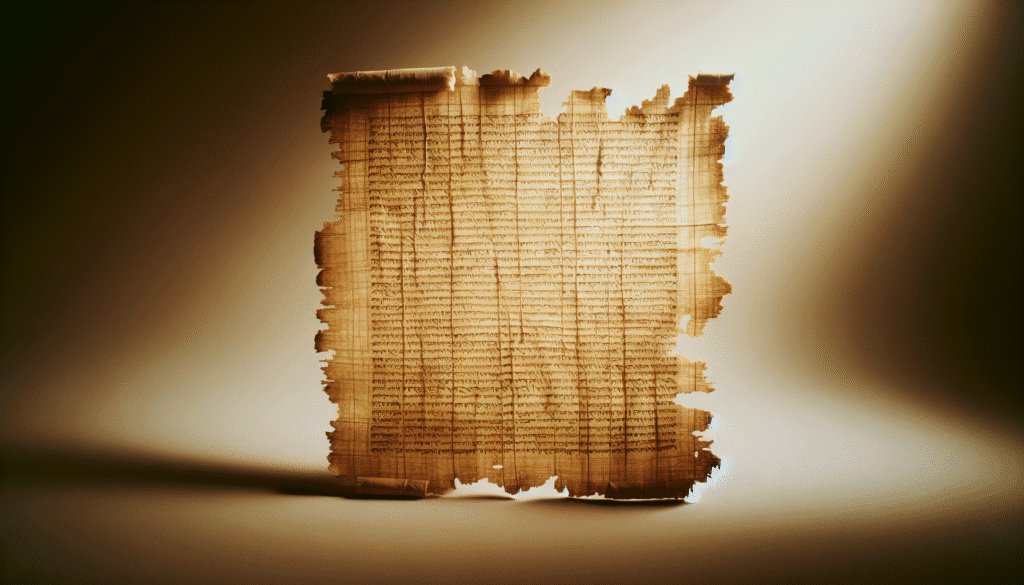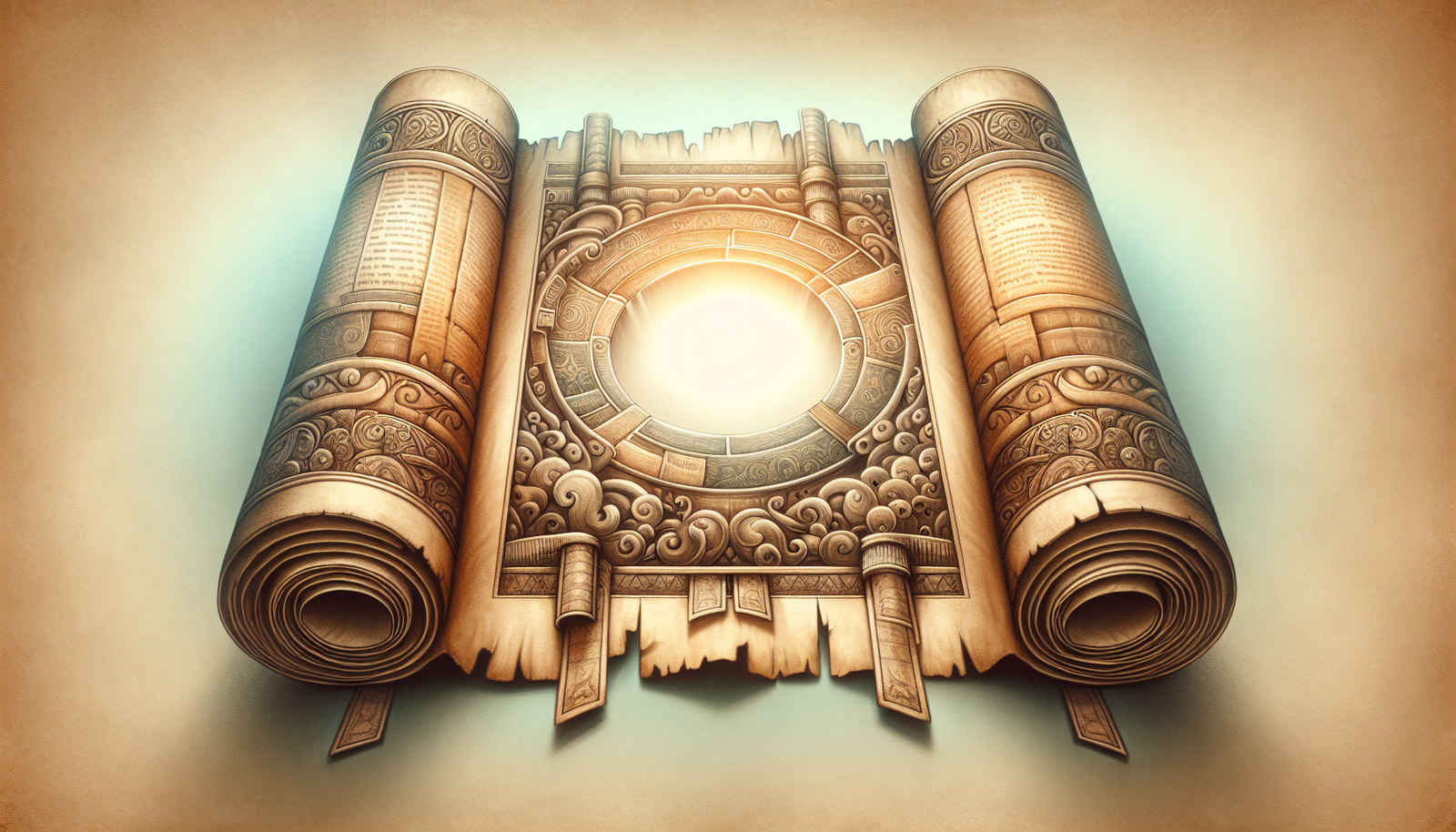Have you ever wondered about the oldest known remnants of the New Testament? Imagine holding a fragment that traces back to Christianity’s earliest days. Welcome to the fascinating world of the John Rylands Papyrus—a captivating window into first-century gospel history.
I’m Dr. Emily Harrington, with a PhD in Theology, specializing in early Christian manuscripts. As 2025 witnesses a surge in interest in ancient texts due to advancements in technology and global connectivity, understanding these treasured fragments has never been more relevant. These pieces aren’t just dry historical artifacts; they’re vibrant testaments to the beginnings of a pivotal religious tradition that continues to influence billions worldwide. The John Rylands Papyrus stands out as a striking example, razor-thin yet rich in significance, offering insights into early Christian communities and textual transmission.
TL;DR Box
- The John Rylands Papyrus is a notable first-century gospel fragment.
- It provides invaluable insights into early Christianity and textual history.
- Advances in technology are unveiling new details about the papyrus.
- Its discovery and analysis reflect ongoing scholarly and public interest.
- Understanding this papyrus enriches the broader historical and religious narrative.

Understanding the John Rylands Papyrus
The John Rylands Papyrus sheds light on understanding Christian origins by bridging past and present. Under this section, we’ll embark on unraveling what makes this fragment special, why it has captured attention, and how it deepens our understanding of early Christianity.
Discovery and Significance
Unearthing the John Rylands Papyrus was akin to stumbling upon a treasure chest for historians and theologians. Originating from Egypt, it was unearthed in the early 1920s and eventually acquired by the John Rylands Library. But what really makes this small piece of papyrus—also known as P52—so significant?
- Age: It’s generally dated to the first half of the 2nd century CE.
- Content: The fragment contains parts of the Gospel of John (18:31-33, 37-38), a foundational text for Christianity.
- Significance: As one of the earliest fragments of the New Testament, it assists scholars in verifying textual consistency across the centuries.
Its age and content position the Rylands fragment as a crucial bridge between the oral traditions of Jesus’ followers and the written records that would form the New Testament. It adds a layer of authenticity and reliability to the scriptural tradition, helping to dispel myths and confirm longstanding practices and beliefs.
The Journey to Manchester
How did this fragment make its way from the sands of Egypt to a library in Manchester? The story is both serendipitous and revealing. Purchased by Bernard Grenfell and Arthur Hunt—two archaeologists renowned for their work in Greek papyri—it was brought to England in 1920. Decades later, it reached the John Rylands Library, where it remains a focal point of study and interest.
- Acquisition: Acquired by the library in 1920.
- Contributors: Grenfell and Hunt vital in its unearthing and global significance.
- Current Display: Accessible to scholars and the public, underscoring the ongoing importance of artifact accessibility.
This journey underscores the dynamic nature of historical artifacts, which often travel vast geographical and temporal distances before reaching the public eye. It’s a testament to human curiosity and the relentless quest for understanding our past.
Inside the Text: Linguistic and Theological Insights
So, what insights does this tiny papyrus fragment offer? The answer lies in both its linguistic nuances and theological implications.
Linguistic Insights:
- Language: The text is in Greek, a common lingua franca of the Eastern Mediterranean at the time, underscoring early Christianity’s multicultural roots.
- Textual Variants: Variants in the text offer evidence for how transmission happened over the centuries, demonstrating both consistency and evolution in Scripture.
Theological Insights:
- Snapshot of Early Christianity: The verses depicted are of profound theological importance, touching on themes of truth, testimony, and kingdom.
- Canonical Confirmation: Reinforces canonicity by closely corresponding to later manuscripts of the Gospel of John.
This dual insight is like looking into a two-way mirror, reflecting both historical context and enduring spiritual messages. It becomes clear that the papyrus is more than a mere artifact; it’s a dialogue across centuries.
Technological Advances in Papyrus Study
As we move further into the digital age, technology continuously revolutionizes our understanding of ancient texts. From scanning techniques to data analysis, exploring these marvels with modern tools offers newfound clarity and detail.
High-Resolution Imaging and Analysis
High-resolution digital imaging has emerged as a game-changer in papyrus studies. By magnifying texts in extraordinary detail, scholars can observe features invisible to the naked eye.
- Infrared Imaging: Reveals faded inks, providing more comprehensive readings.
- Multispectral Analysis: Differentiates materials and offers clues about the papyrus production process and writing techniques.
These technological advances are analogous to moving from an oil lamp to LED lighting—a richer, more nuanced view of ancient manuscripts that elevates our understanding.
Digital Tools and Data Preservation
Digital archives and data preservation techniques ensure the papyrus remains accessible to scholars and enthusiasts worldwide. Digitization not only democratizes access but also safeguards this treasure for future generations.
- Digital Archives: Online databases make the fragment accessible, widening the scope for global academic collaboration.
- Preservation Techniques: Ensures the papyrus remains intact amidst environmental challenges.
This is akin to building a digital bridge spanning centuries, maintaining continuity in our collective quest for knowledge and understanding.
The Role of AI in Textual Analysis
Artificial Intelligence emerges as an ally in unlocking papyrus secrets, acting as a digital detective. Through meticulous analysis, AI can:
- Pattern Recognition: Identify patterns in scribe habits, offering insights into manuscript origins.
- Translation Aids: Provide preliminary translations, accelerating scholarly work.
By partnering with AI, scholars amplify their ability to interpret and understand these texts, ensuring discoveries continue to evolve with advancements in technology.

The John Rylands Papyrus’ Place in Textual Criticism
Textual criticism functions as a scholarly lifeline, examining variations in manuscripts to construct the most accurate historical portrayal. As a centerpiece of textual criticism, the John Rylands Papyrus bolsters this critical academic discipline.
Contributions to Textual Criticism
The papyrus offers invaluable contributions by:
- Verifying Consistency: Provides evidence confirming the reliability of later New Testament manuscripts.
- Highlighting Variation: Any observed variations prompt discussions on early doctrinal differences or scribe practices.
In this symbiotic relationship, textual criticism sharpens our understanding of the papyrus, while the papyrus itself enriches the foundation upon which textual criticism rests.
Comparing with Other Ancient Manuscripts
A side-by-side comparison with other ancient manuscripts amplifies the Rylands Papyrus’ importance. How does it compare with similar finds like the Codex Sinaiticus or the Chester Beatty Papyri?
| Manuscript | Date | Content Overview | Significance |
|---|---|---|---|
| John Rylands Papyrus | ca. 125 CE | Gospel of John 18:31-33, 37-38 | Earliest evidence of the New Testament fragment |
| Codex Sinaiticus | 4th Century | Complete New Testament + Old Testament portions | Provides complete Biblical texts |
| Chester Beatty Papyri | 2nd−4th Century | New Testament texts | Early New Testament books in codex form |
With each comparison, the papyrus underscores its part in a broader narrative—a single brushstroke within the vast painting of early Christian textual history.
Challenges in Textual Criticism
The path to textual clarity isn’t without obstacles. Scholars often grapple with:
- Fragmentary Nature: Limited size and scope challenge comprehensive analysis.
- Bias and Interpretation: Personal and doctrinal biases can color translation and interpretation efforts.
Recognizing these challenges prompts a renewed commitment to rigorous, impartial scholarship—ensuring discoveries are more objective and meaningful.
The Fascination and Public Engagement
The John Rylands Papyrus not only captivates scholars but also fuels public imagination. Its influence extends beyond academia, touching on popular culture, public exhibitions, and broader enlightenment.
Exhibitions and Public Interaction
Exhibits showcasing the papyrus invite curiosity, serving as portals to history. In these curated settings, ancient history becomes accessible and engaging.
- Interactive Displays: Encourage hands-on learning and exploration.
- Collaborations with Museums: Partnering with global institutions to highlight shared cultural heritage.
These exhibitions bring history to life, transforming abstract history lessons into tangible learning experiences.
Cultural and Spiritual Impact
This papyrus transcends academic study, impacting both culture and spirituality. For many, it affirms foundational beliefs or kindles interest in theological exploration.
- Affirming Faith: Provides tangible evidence supporting Christian texts.
- Sparking Dialogue: Invites conversations around relevance, interpretation, and legacy of ancient manuscripts.
In a world where cultural and spiritual identities are constantly evolving, the Rylands Papyrus fuels those discussions, offering perspectives grounded in history.
Community Involvement
Community engagement amplifies the papyrus’ meaning. Workshops, lectures, and educational programs extend its relevance, inviting diverse voices to contribute to its ongoing narrative.
- Educational Programs: Cultivating interest among students and the public.
- Public Lectures: Bridging academia and community curiosity through open dialogues.
As the ancient meets the modern through community involvement, the papyrus transforms into a living piece of history—one that continues to inform, inspire, and challenge perspectives across generations.

FAQs about the John Rylands Papyrus
What is the John Rylands Papyrus?
- The John Rylands Papyrus, also known as P52, is an early Christian manuscript fragment dating around 125 CE, containing parts of the Gospel of John.
Why is the papyrus significant?
- It is one of the earliest known fragments of the New Testament, providing insights into early Christian textual transmission and consistency.
Where is the papyrus currently housed?
- The fragment is housed at the John Rylands Library in Manchester, UK, and is accessible to scholars and the general public.
How does technology aid in studying the papyrus?
- Advances in imaging techniques and artificial intelligence have enhanced our understanding of the fragment, making detailed analysis and global access possible.
Can the public view the John Rylands Papyrus?
- Yes, it’s part of exhibitions and can be viewed online through digital archives, enriching public interaction and engagement.
People Also Ask
How old is the John Rylands Papyrus?
- The papyrus is dated to approximately 125 CE, making it one of the earliest New Testament manuscripts.
What part of the Bible does it contain?
- It contains portions of the Gospel of John, specifically 18:31-33 and 37-38.
Is the John Rylands Papyrus the oldest New Testament manuscript?
- It is among the oldest known fragments, although not the oldest complete manuscript.
What techniques are used to study the papyrus?
- Scholars use techniques like high-resolution imaging and digital analysis to study the papyrus in detail.
How did the John Rylands Papyrus get its name?
- It was named after the John Rylands Library in Manchester, where it is preserved.
With the insights gathered from this exploration, the John Rylands Papyrus emerges not merely as an ancient fragment but as a pivotal chapter in the story of biblical transmission and cultural heritage. As technology advances and scholarly curiosity intensifies, our collective understanding of these fragments continues to expand, revealing ever-deeper layers of our shared human history.




